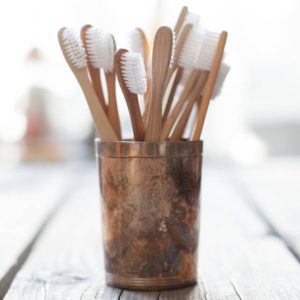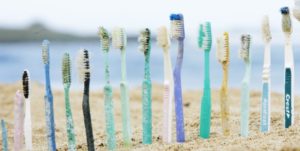 Good oral health has always been a pillar of good overall health. Most prehistoric hunter-gatherer cultures subsisted on a tooth-friendly diet heavy in vegetables, nuts, insects and meats, and many ancient skulls show little evidence of tooth decay. With the advent of farming, modern societies became possible with a shift to grain-based carbohydrates and sugars. Studies tracing the bacteria in tooth plaque from the stone age through the industrial era show this worldwide dietary change resulted in widespread oral disease, and the advent of the need for good oral hygiene to achieve good oral health.
Good oral health has always been a pillar of good overall health. Most prehistoric hunter-gatherer cultures subsisted on a tooth-friendly diet heavy in vegetables, nuts, insects and meats, and many ancient skulls show little evidence of tooth decay. With the advent of farming, modern societies became possible with a shift to grain-based carbohydrates and sugars. Studies tracing the bacteria in tooth plaque from the stone age through the industrial era show this worldwide dietary change resulted in widespread oral disease, and the advent of the need for good oral hygiene to achieve good oral health.
Archaeological evidence can trace toothbrushes back to the early dawn of human civilization, with “chew sticks” comprising of a twig with one frayed end used for scrubbing teeth showing up many thousands of years BCE. The toothbrush we recognize today first took form in 15th century China, where bamboo handles studded with coarse hairs or bristles begin to appear. The industrial revolution added both cavity-increasing processed foods to the human diet and the first mass-produced toothbrushes in response. The synthetic materials common in current brushes only became available in the 20th century, with 1930s inventions like nylon for bristles becoming ubiquitous with returning troops after World War II. The booming postwar American culture spread to all corners of the globe a reliance upon cheaply produced, extraordinarily durable plastics as short-lived, disposable amenities. Decades later, a globe awash in nonbiodegradable waste is now coming to realize that more environmentally responsible practices will be necessary to maintain a healthy ecosystem.
 The American Dental Association recommends changing a toothbrush every 3-4 months, because a worn toothbrush head is less effective at removing dental plaque. By the numbers, this is 1.2 billion toothbrushes thrown away annually for the US population alone. Most modern toothbrushes are designed for effectiveness, comfort and marketing esthetics. Today’s toothbrush designs do not integrate recycling or disposal costs, which results in products molded of several different hard and soft plastics not well suited for recycling. Rather than depend on the recycling industry to create a market for post-consumer toiletries, eco-minded consumers are looking for toothbrushes designed from the outset with a plan for the products end of life.
The American Dental Association recommends changing a toothbrush every 3-4 months, because a worn toothbrush head is less effective at removing dental plaque. By the numbers, this is 1.2 billion toothbrushes thrown away annually for the US population alone. Most modern toothbrushes are designed for effectiveness, comfort and marketing esthetics. Today’s toothbrush designs do not integrate recycling or disposal costs, which results in products molded of several different hard and soft plastics not well suited for recycling. Rather than depend on the recycling industry to create a market for post-consumer toiletries, eco-minded consumers are looking for toothbrushes designed from the outset with a plan for the products end of life.
Reusables
The part of a toothbrush that needs replacing is comprised of worn out, bacteria harboring bristles, and therefore toothbrushes that reduce overall waste by offering a reusable handle and replaceable brush head are a logical choice. These brushes will offer many of the same materials and esthetics of disposable brushes. Swap-able disposable heads are currently a common design feature of expensive electric toothbrushes, and this swap-able toothbrush head feature is growing in popularity with standard manual brushes from traditional manufacturers.
Plastic alternatives
This category includes natural fiber or silk floss and brushes or floss picks made from materials like cellulose or bamboo and is an option that allows consumers to use less-plastic, while not yet being plastic-free. Compostable- and bio-based alternatives to industry standard nylon bristles and Teflon floss do not currently exist at scale, but companies are working to develop successful alternatives that can mean less virgin plastic gets produced in the first place. Disposed items shouldn’t be considered “biodegradable” unless a disposal supply chain can illuminate exactly how the recycling process will be managed, where, and by whom. Commercial composting facilities operate in a completely separate realm from traditional glass/metal/plastic recycling facilities and can handle a variety of organic and compostable materials, but each is different in capability. Business and household recycling bins lead to municipal systems not currently equipped to separate out plant-based from plastic-based items, and anything ending in landfill doesn’t really break down, regardless of what material it is.
Consumer Awareness
The companies that produce our products are extremely sensitive to market changes. As voter-mandated regulations or consumer preferences shift, companies and the products they sell adapt. Here are seven suggestions for small lifestyle changes that can accumulate into a sustainability sea-change for the oral healthcare industry and society at large.
- Support products designed with a plan for waste management or reduction, including extended producer responsibility schemes where companies take back materials through mail-in or drop-off programs
- Carry reusable bags as a routine, whether shopping or to the dental office
- Carry reusable water bottles, and even utensils and straws
- Check if your dental office uses steam sterilization pouches instead of disposable tools when possible, and uses digital rather than film radiographs
- If your dental office depends more on disposable tools and still uses film radiographs, voice your preference for change to your dentist!
- Avoid toothpastes and other toiletries listing “polyethylene” or “polypropylene” as an ingredient, as these sand-sized scrubbing flecks of microplastic all end as ocean pollution, do not offer any medical benefit, and get lodged in your gums
- Seek recycling programs like Terracycle, that accept toothbrushes and toothpaste tubes (and lots of other materials!) and recycle them into new materials and products
- Dentists have your health as a priority! As they study the effectiveness of new techniques and products with smaller footprints such as compostable floss or reduced-packaging toothpaste tablets, they will recommend those products that are shown to be healthy alternatives. Communicate your wants.
As a bonus bullet point, I leave the eco-minded patient with this...
- No, sadly, charcoal or swishing coconut oil CANNOT replace brushing, flossing and fluoride rinse at preventing cavities!
By Andrew Danberg-Ficarelli, D.M.D.



